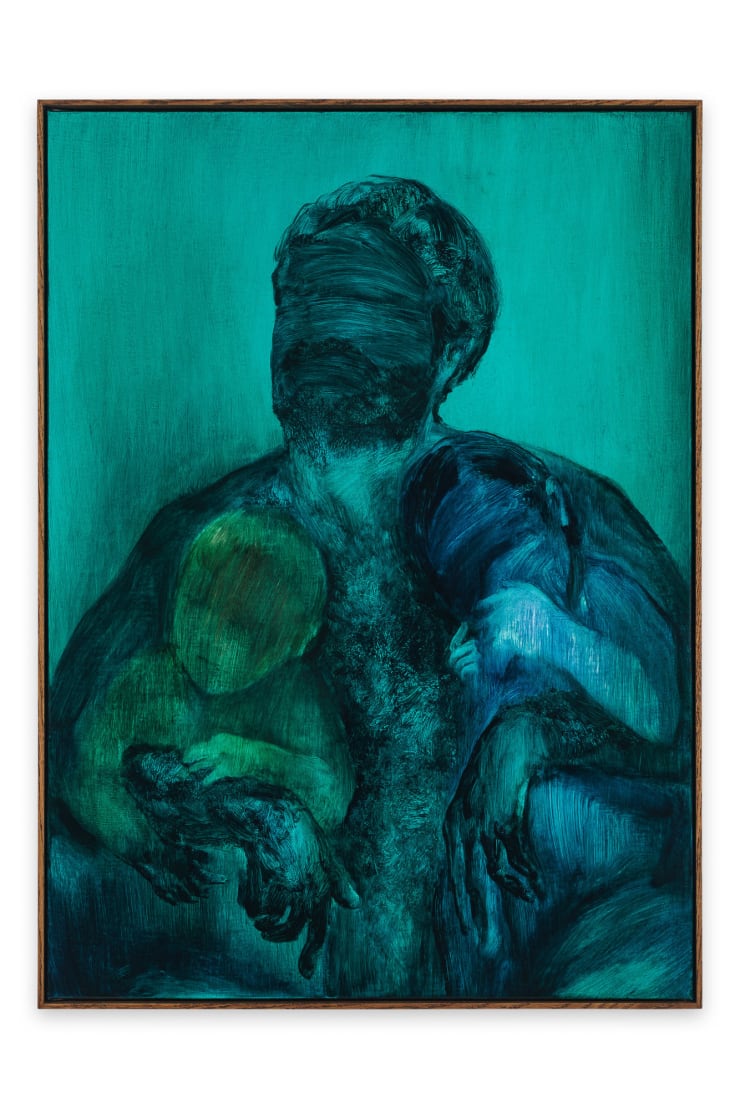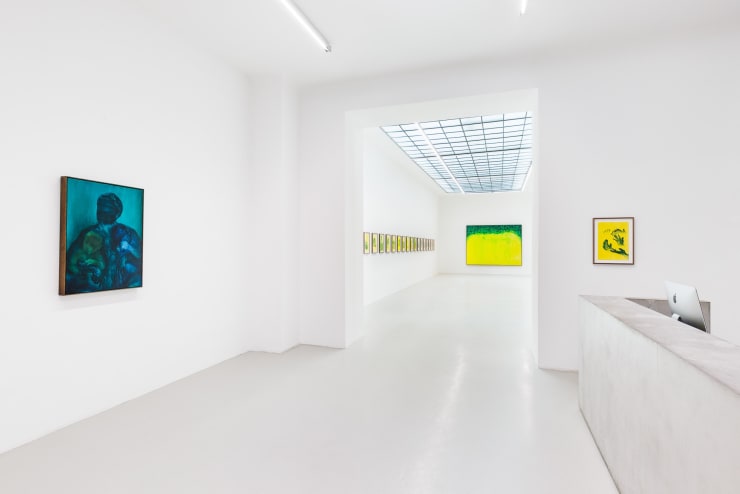Xie Lei | Nachleben
We can confidently approach the exhibition titled "NACHLEBEN" as a manifestation of Xie Lei's artistic growth and diverse intellectual curiosity, this time referencing the concept of reframing introduced by Aby Warburg in his profound work. Warburg’s "Nachleben" bears witness to the secret life of visual perception in art, where images are transcending their original context, evolving through time, cultures, and artistic interpretations. Xie breathes life into his works as he navigates along the shores of this idea on his own terms, as we can observe in Vienna at Galerie Kandlhofer.
Warburg developed the concept of "Nachleben" to explore how images, motifs, and themes from the past continue to resonate and influence artistic production in the present. For Xie Lei, the concept of "Nachleben" endows him with a distant mirror image when dealing with the interplay between literature, Eastern and Western artistic traditions, contemporary art practices, and more. By delving into the afterlife of cultural elements such as symbols, narratives, and aesthetic principles, Xie explores how previous art forms and literary sources have been reinterpreted, transformed, or revived in contemporary art. This research provides him with the inventiveness to create new works that reflect a synthesis of traditional and contemporary influences. Furthermore, the concept of "Nachleben" assists Xie in understanding the broader cultural and intellectual context in which he works, developing a deeper and multi-layered comprehension, especially when working in the realm of visual arts.
Throughout the exhibition "Nachleben," Xie Lei draws inspiration from various sources, including ancient Chinese narratives and iconic European paintings, integrating them with his own personal experiences and reflections. In doing so, he raises questions about the preservation of cultural heritage in the face of globalization, the tension between tradition and modernity, and the possibilities of cultural exchange and mutual influence. By merging cultural issues and Western art historical references, Xie invites viewers to contemplate the complex dynamics between cultures and the evolving nature of contemporary art, which sometimes evolves in unexpected directions.
Excerpt of an essay by Christian Dominguez
-
 Xie LeiAdoration, 2023Oil on canvas205 x 270 cm
Xie LeiAdoration, 2023Oil on canvas205 x 270 cm
80 3/4 x 106 1/4 in -
 Xie LeiInstallation View: Adoration, 2023Oil on canvas205 x 270 cm
Xie LeiInstallation View: Adoration, 2023Oil on canvas205 x 270 cm
80 3/4 x 106 1/4 in -
 Xie LeiTBT, 2023Oil on canvas160 x 205 cm
Xie LeiTBT, 2023Oil on canvas160 x 205 cm
63 x 80 3/4 in -
 Xie LeiAbandon, 2023Oil on canvas160 x 205 cm
Xie LeiAbandon, 2023Oil on canvas160 x 205 cm
63 x 80 3/4 in -
 Xie LeiTBT, 2023Oil on canvas205 x 160 cm
Xie LeiTBT, 2023Oil on canvas205 x 160 cm
80 3/4 x 63 in -
 Xie LeiInstallation View: Prediction, 2023Oil on canvas205 x 160 cm
Xie LeiInstallation View: Prediction, 2023Oil on canvas205 x 160 cm
80 3/4 x 63 in -
 Xie LeiRefold, 2023Oil on canvas50 x 65 cm
Xie LeiRefold, 2023Oil on canvas50 x 65 cm
19 3/4 x 25 5/8 in -
 Xie LeiPressure II, 2023Oil on canvas40 x 50 cm
Xie LeiPressure II, 2023Oil on canvas40 x 50 cm
15 3/4 x 19 3/4 in -
 Xie LeiCherish I, 2023Oil on canvas30 x 24 cm
Xie LeiCherish I, 2023Oil on canvas30 x 24 cm
11 3/4 x 9 1/2 in -
 Xie LeiCherish II, 2023Oil on canvas40 x 30 cm
Xie LeiCherish II, 2023Oil on canvas40 x 30 cm
15 3/4 x 11 3/4 in -
 Xie LeiProtection, 2023Oil on canvas90 x 65 cm
Xie LeiProtection, 2023Oil on canvas90 x 65 cm
35 3/8 x 25 5/8 in -
 Xie LeiPressure I, 2023Oil on canvas40 x 50 cm
Xie LeiPressure I, 2023Oil on canvas40 x 50 cm
15 3/4 x 19 3/4 in -
 Xie LeiStill Life IV , 2023BacksideOil on paper42 x 30 cm
Xie LeiStill Life IV , 2023BacksideOil on paper42 x 30 cm
16 1/2 x 11 3/4 in -
 Xie LeiStill Life X, 2023BacksideOil on paper42 x 30 cm
Xie LeiStill Life X, 2023BacksideOil on paper42 x 30 cm
16 1/2 x 11 3/4 in -
 Xie LeiStill Life XIX, 2023BacksideOil on paper42 x 30 cm
Xie LeiStill Life XIX, 2023BacksideOil on paper42 x 30 cm
16 1/2 x 11 3/4 in -
 Xie LeiStill Life IX, 2023BacksideOil on paper42 x 30 cm
Xie LeiStill Life IX, 2023BacksideOil on paper42 x 30 cm
16 1/2 x 11 3/4 in -
 Xie LeiStill Life XII, 2023BacksideOil on paper42 x 30 cm
Xie LeiStill Life XII, 2023BacksideOil on paper42 x 30 cm
16 1/2 x 11 3/4 in -
 Xie LeiStill Life XIV, 2023BacksideOil on paper42 x 30 cm
Xie LeiStill Life XIV, 2023BacksideOil on paper42 x 30 cm
16 1/2 x 11 3/4 in -
 Xie LeiStill Life I, 2023BacksideOil on paper42 x 30 cm
Xie LeiStill Life I, 2023BacksideOil on paper42 x 30 cm
16 1/2 x 11 3/4 in -
 Xie LeiStill Life XVI, 2023BacksideOil on paper42 x 30 cm
Xie LeiStill Life XVI, 2023BacksideOil on paper42 x 30 cm
16 1/2 x 11 3/4 in
-
 Xie LeiInstallation View: Nachleben , 2023
Xie LeiInstallation View: Nachleben , 2023 -
 Xie LeiInstallation View: Nachleben , 2023
Xie LeiInstallation View: Nachleben , 2023 -
 Xie LeiInstallation View: Nachleben , 2023
Xie LeiInstallation View: Nachleben , 2023 -
 Xie LeiInstallation View: Nachleben , 2023
Xie LeiInstallation View: Nachleben , 2023 -
 Xie LeiInstallation View: Nachleben , 2023
Xie LeiInstallation View: Nachleben , 2023 -
 Xie LeiInstallation View: Nachleben , 2023
Xie LeiInstallation View: Nachleben , 2023 -
 Xie LeiInstallation View: Nachleben , 2023
Xie LeiInstallation View: Nachleben , 2023 -
 Xie LeiInstallation View: Nachleben , 2023
Xie LeiInstallation View: Nachleben , 2023 -
 Xie LeiInstallation View: Nachleben , 2023
Xie LeiInstallation View: Nachleben , 2023 -
 Xie LeiInstallation View: Nachleben , 2023
Xie LeiInstallation View: Nachleben , 2023 -
 Xie LeiInstallation View: Nachleben , 2023
Xie LeiInstallation View: Nachleben , 2023 -
 Xie LeiInstallation View: Nachleben , 2023
Xie LeiInstallation View: Nachleben , 2023

































